 |
An unrecorded class 25 with a long train of oil tanks dropping down Miles Platting Bank towards Manchester Victoria in February 1984. My note taking in those was at best
sporadic and sometimes non-existent.
|
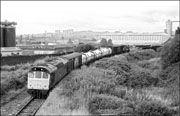 |
This picture shows 25213 on the branch from the Albright and Wilson terminal near Langley Green station with empty tanks on 29 August 1986. This was the Oldbury branch, truncated in the 1960s to serve just
the works to which tanks of chlorine gas were taken. I took this shot rather than the one showing more of the locomotive in order to include more of the industrial
landscape. The scene here would not be recognisable as the same spot in 2025 with the branch line having gone and everything overgrown.
|
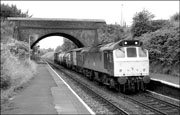 |
The second photograph in this sequence shows 25213 running through the now-closed Smethwick West station with T48 returning to Bescot with the empty chlorine tanks on 29 August 1986. Shortly after
this date, the train of tanks ceased running to Bescot but ran directly from Langley Green to Wilton as 6E70. Smethwick West station has since closed having been replaced with Galton Bridge
Interchange, following the re-opening of the GWR line from Birmingham Snow Hill via the Jewellery Quarter and is now a two-level station where pasengers can change to and from the electrified Wolverhampton line.
|
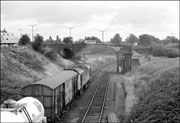 |
My final shot of 6T48 on 29 August 1986 shows 25213 leaving the platforms of Smethwick West station and about to join Wolverhampton to Birmingham main line from where it would have swung left at
Soho Junction and made its way back to Bescot. The branch to Handsworth can clearly be seen to the left of the train and the signalbox controlling the junction is visible on the right. I understand that
this was not a good place to work, in the latter years at least, as it was cold, draughty, had a thriving population of rats in the frame chamber and was under regular attack from local yobs. All in all,
not a box missed by too many people other than those of us with a liking for such infrastructure. Colour versions of these three pictures taken at the same time on a second camera can be found further down this page.
|
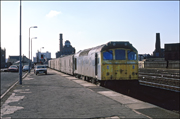 |
Light police look away now! This fiercely backlit image was taken at Manchester Exchange on 27 February 1986 as 25321
took a short train of newspaper vans along the bi-directional line towards Victoria station. The main reason I took this shot was because
of the dreadful state of the front end which looked as if it been cleaned with coarse sandpaper. Despite its appearance 25321 was not scrapped but in 2025 (according to Wikipedia) is stored at the Midland Railway centre at Butterley.
|
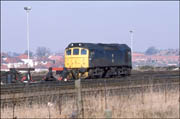 |
This is a telephoto lens view of the yard at Stourbridge Junction on 8 March 1986 taken from a piece of derelict land on the other side of the line. The locomotive, 25205, was there after
a Friday night shift banking a couple of freights up the incline of Old Hill Bank and was probably waiting for another heavy train later in the afternoon or evening.
|
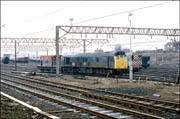 |
In 1986 there was still a fair amount of activity in and around Bescot Yard. On 5 March several types of wagons were visible in the backgrouns as 25230
took a single brakevan around the back of Bescot Stadium station. Within 12 months the class was entirely withdrawn from general use although a few were kept
for use largely on railtour duties.
|
.jpg) |
These pictures from around Gobowen station were taken on 2 June 1986 on the Shrewsbury to Crewe line showing 25059 with a train of ballast from Blodwell quarry on the former
line to Oswestry; 7G25 15.21 Blodwell Quarry - Bescot Up Yard. The first shows the train curving off the branch and approaching the station. I arrived without knowing if the train had run but the man
in the ticket office rang the signalbox to find out and the signalman said that it wasn't far away and I was welcome to walk up into the old yard for my photographs. Before the ballast arrived 56044 hauling a cement train
was signalled and duly photographed.
The weather was poor but this train was usually 31 hauled by this time, 2 June 1986, meaning that the chances for further shots
of this nature were limited. Furthermore, the friendly signalman who allowed me to obtain these pictures may not have been on duty on another visit!
|
.jpg) |
This shot from the site of the yard at Gobowen station shows 25059 in the process of running round its train of mixed ballast wagons while working 7G25, the 15.21 Blodwell Quarry to Bescot on 2 June 1986. I included the picture
largely to give a view of the signalbox and to show the bracket signal with the branch arm lowered.
|
.jpg) |
My final picture of 25059 at Gobowen was taken as 7G25 to Bescot left the station. A lot of the old railway including telegraph poles with multiple wires was still in evidence at this time, 2 June 1986 but
I imagine that these will have gone by 2022 although I believe that some semaphores are still extant here.
|
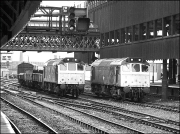 |
Going into Manchester Victoria was to enter a world of light and shade which was just the job for black and photography. This shot shows 25313 on what I believe to be
the 9T46 Horwich trip on 26 June 1984 and passing 25307 waiting for its next turn assisting a freight up Miles Platting bank. It didn't have to wait long as this picture of it assisting 40091 on a Stanlow to Leeds oil train shows.
|
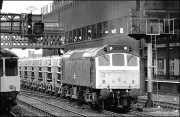 |
This is possibly one of my favourite black & white shots of a class 25 showing 25288 passing through Manchester Victoria on 26 June 1984 with what I take to be a rake of PFA or cement wagons. The class 104 DMU waiting to head towards the west
is a bit of a nuisance but does remind one of the photographic challenges faced in this wonderfully atmospheric station. I have no idea of the working
but I don't recall seeing a similar one on any other occasion so perhaps it was some withdrawn wagons going for scrap.
|
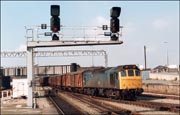 |
Here is a picture I took at Chester on 26 September 1984 while in the city for work-related reasons rather than a photographic outing. I usually managed to find space in my briefcase for a camera just in case there anything around worth taking. This definitely fell into this category and
shows 25284 with a lovely rake of UIC ferry vans of either French or Yugoslavian origin using the station avoiding lines.
The most likely point of origin for the old-style ferry vans in the photo is Wrexham Watery
Road goods depot, where steel from Brymbo was loaded after closure of the Brymbo branch.
Thanks to Brian Williams and Paul Shannon for the information on the wagons and the probable
origin of the traffic.
|
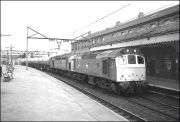 |
The Broughton Lane to Ditton BOC train was, in 1984, a very popular train with enthusiasts as it was regularly hauled by class 25 and 40 in multiple. This was my only attempt at this train and shows
25276 + 40079 passing Guide Bridge on 31 May 1984. The line through Guide Bridge was very busy with freight
at this time and was a happy hunting ground for those interested in classes 25 and 40. There was also the regular passenger service from Manchester Piccadilly to Hadfield utilising the 1500v DC units.
|
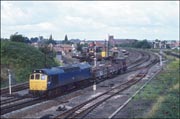 |
This image was taken at Sutton Bridge Junction, Shrewsbury on 27 August 1986 and shows 25288 about to reverse into the small permanent way yard. The second shot I took was from a few minutes later when the shunt
had been completed and with the sun doing its best to make life difficult! This location is now known as Coleham Depot and much
of the infrastructure has changed as can be seen in this picture from Wikipedia.
|
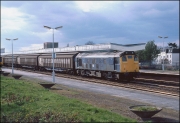 |
This image, taken at Leamington Spa on the evening of 26 April 1985 shows 25034 on the up main with the afternoon Longbridge to Cowley car parts ABS
train. This was loaded to 23 vans which was about the normal length at the time and would really have made the loco work on the climb through Whitnash
and up to Harbury Tunnel. My note says that it was taken on 100asa film using 1/125 at f4 which may account for the slightly unsharp image. The light must have
been worse than it looked.
|
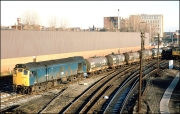 |
Here is another photograph of the same locomotive as above but taken on 26 November 1985 at Warrington Arpley. The train is about to dive under the WCML and head to the
Liverpool area. There were several class 25 workings at Warrington during the day, but this was the only one for which the sun appeared at full strength.
|
_25175_Warr_bquay) |
Earlier the same day, 26 November 1985, 25201+25175 took a trip working of a rake of HAAs through Bank Quay station seen here at the north end of the station. This shotg was taken on Ektachrome 100 slide film which does give some
variable results in less than full sun and this hasn't come out at all well. As usual, the elapsed time since taking it has made the picture more attractive. This going-away shot from the other end of the platforms was taken both to
show the industrial landscape in the background and to take advantage of the bit of reflected sunlight.
|
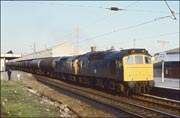 |
As with the class 40s, the majority of the 25s final workings took place around the north-west as typified by the this view of 25285 + 25279 leaving Warrington Bank Quay station after a crew change on 26 November 1985
with a Stanlow to Leeds tank train. Note the different types of tanks with 2 large bogie vehicles behind the locomotives but 4 wheel examples forming the rest of the long train.
|
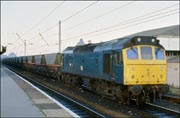 |
I was about to leave Warrington for the journey home on 26 November 1985 when 25145 turned up on some more HAA MGR hoppers. Given that the light had just about died altogether the photograph seemed
to be a waste of time until I noticed that it had the legend "RR" mon the nose and had been unofficially named "Roland". A terrible shot but worth a frame for the historical value. Maybe.
|
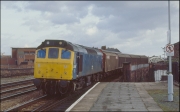 |
This photograph of 25321 was taken at Leamington Spa on 1 February 1985 and shows the locomotive heading onto the down through line with a short train of vans. I'm not entirely
sure of the working, but imagine that it was the daily Banbury to Bescot trip. It was always good to hear the points grind over at the south end of the station after a down passenger working
as it almost invariably meant that a freight was on the way. If the centre road signal was cleared the train was routed via Hatton and Solihull, or if the aspect remained red the train
would be going via Coventry, as the signal and its associated feather for the branch would not clear until the train was part way through the station.
|
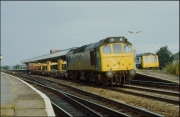 |
Another platform-end shot from Leamington Spa this time taken on 10 August 1985 shows 25206 waiting to head south to Banbury with a short train of rail slingers and a brake van. Also of interest is the class 116 DMU
stabled behind the station building and although this line is still in place I don't think that it goes quite so far behind the station in 2021.
|
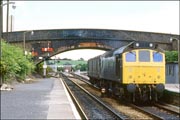 |
In 1985, there was a Saturday morning van train from Birmingham's Curzon Street Parcel depot to Worcester. Running as 3V16, it turned up with one of Saltley's spare engines, of which there would have been many
on a Saturday. I saw the train with classes 25, 31, 40, 45 and 47 and here it is with the first of those passing Droitwich Spa station on 6 July 1985. The sun had just gone behind a large bank of cloud, so I took the opportunity
to photograph 3V16 behind 25285 from the platform so as to include the centre-pivot lower quadrant signals and the old-fashioned telegraph poles, the latter of which were not long for this world. The signals are still
in place, but the scene here has dramatically changed in the past few years, so much so that it is now difficult to take a decent picture of a train coming from the north in the morning on a sunny day.
|
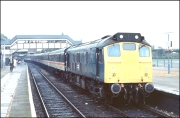 |
My home town of Stratford-upon-Avon was visited on an almost weekly basis in 1985 by the steam-hauled "Sunday Luncheon Express" from London Marylebone.
To simplify and speed up the shunting moves a diesel locomptive was sent down from Bescot or Saltley. Class 31s were found to struggle with the heavy
stock, especially if the rail conditions were poor so on 18 August 25042 appeared and had no problem at all moving the stock from platform 1 into
platform 2. The class 25, as a rare visitor, was of Clan Line. The weather wasn't great and light rain fell during most of the day.
|
_sle_sona) |
Part of the shunting procedure at Stratford-upon-Avon on 18 August 1984 was to move the crew support coach to the front of the train before 35028 Clan Line took the tour
back to London Marylebone. The locomotive on the day was 25042 and it's seen here waiting at the ground signal at the end of platform 1 so that it move forward before propelling
the coach onto the stock. Few other photographers present bothered to picture this scene but were waiting for the steam locomotive to return tender-first from its turning move to Hatton and Dorridge.
|
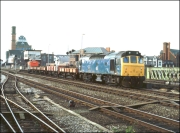 |
The next view was taken at Manchester Exchange, adjacent to Victoria station on 27 October 1984 and shows 25201 on a departmental working which I believe may be the 9T46 Horwich trip. This part of Manchester drew me north from
Warwickshire on many occasions. The industrial background, the likelihood of encountering class 25s and 40s along with virtually every other loco type on
freight workings and the sheer volume of traffic made it irresistible to me. Of particular interest are the round searchlight signals visible over the first wagon of the train and it wasn't long before these were replaced with mopre modern types.
The vista around Manchester Victoria has changed beyond recognition since those days and I consider myself
fortunate that I visited the area on sufficient occasions to record the scene as it was in the 1980s.
|
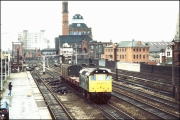 |
Another view from from Manchester Exchange in December 1984 shows 25251 on another departmental working, again possibly the 9T46 trip, which is just about to pass through Victoria station. Just look at this fantastic industrial and railway backdrop which cannot
photographed today. The fact that this was taken on a very dull
and wet 20 December 1984 doesn't matter to me it is the nostalgic content that it is important. Although when using slide film it was good to have the sun for colour photography, my attitude has always been that one should always take the picture whatever the
conditions because 1) there may not be another chance and 2) if there is another chance then you may be able to improve the shot then.
|
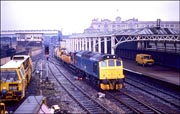 |
It was a good job that this train headed by 25251 was stationary on the through road at Manchester Victoria as it was almost dark when it paused here for a crew change. It had gone through here in the opposite
direction a short while earlier. Writing in 2021 it is hard to believe just how many freight movements with different classes of locomotive there were to photograph here in the 1984/85. I haven't been there since 1985
but I do know that the track layout has been radically changed and that there is an awful lot less traffic.
|
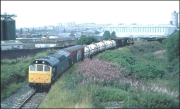 |
This picture shows 25213 returning from the Albright and Wilson terminal near Langley Green station with empty tanks on 29 August 1986. This was the Oldbury branch, truncated in the 1960s to serve just
the works, to which tanks of chlorine gas were taken. I never had the luxury of sun at this location with class 25s, this being reserved for 31s and 37s. Pictures of these will be
found in the appropriate sections of this site.
|
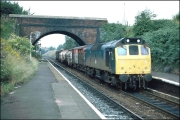 |
The penultimate photograph in this sequence shows 25213 running through the now-closed Smethwick West station with T48 returning to Bescot with the empty chlorine tanks on 29 August 1986. Shortly after
this date, the train of tanks ceased running to Bescot but ran directly from Langley Green to Wilton as 6E70. Smethwick West station is now closed, having been replaced by the Galton Bridge
interchange, following the re-opening of the GWR line from Birmingham Snow Hill via the Jewellery Quarter.
|
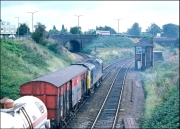 |
My final shot of 6T48 on 29 August 1986 shows 25213 leaving the platforms of Smethwick West station and about to join Wolverhampton to Birmingham main line from where it would have swung left at
Soho Junction and made its way back to Bescot. The branch to Handsworth can clearly be seen to the left of the train and the signalbox controlling the junction is visible on the right. I understand that
this was not a good place to work, in the latter years at least, as it was cold, draughty, had a thriving population of rats in the frame chamber and was under regular attack from local yobs. All in all,
not a box missed by too many people other than those of us with a liking for such infrastructure.
|
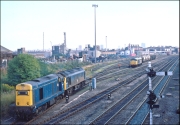 |
When I arrived at Langley Green on the morning of 9 September 1986 a class 31 was standing in the yard looking as if it had had some sort of problem and couldn't
carry on with 6T48. After quite a wait 25057, unusually coupled to 20303 appeared, and ran to the end of the yard where they were separated. The class 25 did the
trip down the branch while 20303, one of the class renumbered after some vacuum pipe modifications to work on stone trains from Buxton, took the 31 back to Bescot. A pair pf these 20s was seen at Bescot for a short time
so this is quite probably a pretty rare view of one working without its partner. The cement tanks and empty scrap wagons in the yard were destined for Blue Circle and Cooper's
scrapyard on the Handsworth branch and woould probably have been tripped there during the afternoon, or possibly the following day. Another rare shot I took here
was of 58009 which arrived light engine from Bescot on 22 May 1991, presumably to go along the Oldbury branch to work 6T48. After some discussion,
the driver decided that he wouldn't take such a long locomotive around the very sharp curve from the yard to Albright & Wilsons siding and returned light to Bescot. Note that the ground
signals controlling the yard are now electric lamps operated from Stourbridge Junction, all the local mechanical signalboxes having been abolished.
|
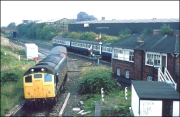 |
The next picture shows 25057 with a barrier van returning from the terminal on 9 September 1986. I saw locomotives on both ends of trains here which perplexed me a little as there were no run-round facilities at Albright and Wilson's site.
Here is another view of 25057 as it enters the yard at Langley Green a few minutes later and well before the semaphore signalling was removed in favour of a more modern but less attractive installation.
The cement wagons in the middle distance would have come from or were going to Blue Circle depot at Handsworth.
|
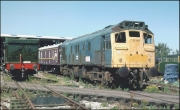 |
As an aside, here is a later pictue of 25057 while awaiting restoration at the Quainton Road centre, Buckinghamshire on 6 May 1988. The locomotive was latr moved to the North Norfolk Railway where
a full restoration was carried before seeing extensive use. I should very much to see a class 25 or two back on the main line working a decently heavy train...
|
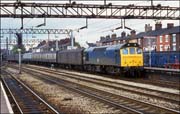 |
Stafford station used to be a major hub for the interchange of parcel traffic and during the 1985 remodelling of Crewe there were even more trains being dealt with. On 11 June 1985
I photographed 25259 entering the platform loop with a short train of 6 NPCCS. Note the line BRUTES and a vintage-looking open trolley all of which were still in daily use at this time.
|
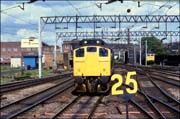 |
This picture was taken at Stafford on 15 June 1985 and shows just how helpful to enthusiasts BR used to be as 25080 running light engine from Crewe passed
a sign clearly identifying the locomotive class for anyone who did not know.
|
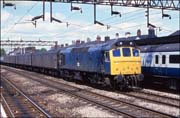 |
Not long after I had taken the picture of 25080 on 15 June 1985 shown above, another of the same class appeared with a very long train of vans which I managed to curtail in a way
that I hope would not happen today. I was actually at Stafford to take some shots of the 4 class 40s (renumbered as 97s) which were in use during a major remodelling of Crewe station
but a class 25 in the sun was not to be ignored.
|
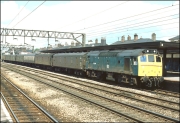 |
The class 25 activity at Stafford on 15 June 1985 contined when 25266 arrived at the station with an van train. My notes are, as usual, totally inadequate but if memory serves this
was a Bangor to Northampton working. I may add that the original transparency shows the full length of the train but half of 1 van was lost during the scanning process.
|
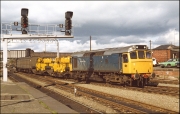 |
25322 was one of the first "celebrity" locomotives after being painted into a non-standard livery and named Tamworth Castle. It is here seen entering Chester with a departmental working on 2 October 1984.
This picture looks very dated now, the scene including a Mk 1 Vauxhall Cavalier in a particularly unpleasant shade of green and an Austin Allegro.
|
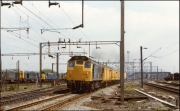 |
Class 25s were quite commonplace around Bescot in 1984 so it was good to see one on a slightly unusual working now and again. Here is 25064 approaching the station
on 30 April of that year with what appears to be at least part of a breakdown train. Note also the selection of English Electric motive power in the holding sidings
along with a class 56 just visible in front of the class 25, and an 86 about to pass under the bridge in the background.
|
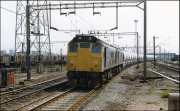 |
Here is another class 25 shot from Bescot on 30 May 1984. This time it's a pair of the small-windown variety, 25244 + 25051 on the MWFO Curzon Street to Pennyffordd empty
cement tanks. Looking back from 2007, it seems incongruous that there was a major rail-served cement terminal right in the heart of Birmingham, but there it was, pretty much
on the site of the original Lonndon to Birmingham Railway's original terminus to the city. I suppose that with the amount of building being done in the area in the 1980s, it made good sense
to have access to the most important raw material as close as possible to the work sites. That joined-up thinking has, sadly, gone by the board these days. Thanks to Andy Williams and David Hayes for the train ID.
|
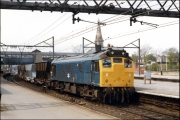 |
Guide Bridge station in Greater Manchester was a great place to see many classes of locomotive in 1984, not least class 25. Here, on 2 May 1984, is 25084 heading east with a
short train of large hoppers. I had no way of identifying train movements in those days; it was simply a matter of arriving at a location and photographing
whatever turned up. Guide Bridge simply oozed with atmosphere before the area was rationalised and appeared to have seen few changes in the preceding
50 years.
|
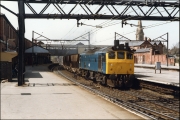 |
This slightly earlier picture was taken on 26 May 1984 and shows another variety of class 25 in virtually the same position as the shot of 25048 shown above. The photographs demonstrate
the differences in bodywork between the two types. The working appears to be the same as the one in the preceding picture, so it can safely be assumed that it was a timetabled service, possibly
an ICI working, as I seem to recall that this type of large hopper was used on that service.
|
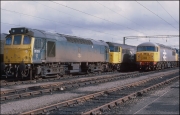 |
I've never been all that fond of static subjects, but just now and again a shot cries out to be taken. This one, from Bescot on 28 March 1986, shows a rather care-worn 25213 in the holding sidings along with 31110 and 56041 among others. At this time
no-one seemed to mind enthusiasts wandering off the end of the platform to have a look at the assortment of locomotives stabled over the weekend - I doubt that this is the case today.
|
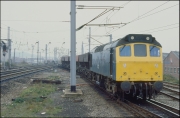 |
An earlier trip to trip to Warrington, this time on 17 October 1985, produced this shot from Bank Quay platform of 25316 hauling a short rake of coal hoppers and what appear to be cement tanks. As can be seen from the
misty background, the weather was dull in the extreme.
|
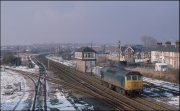 |
It's strange how time lends enchantment to what was once an everyday and not at all notable scene. I have barely looked at this transparency of 25201 passing Wigston South signalbox in Leicester; after all, it is a just a light diesel passing a signalbox
heading off somewhere. It was taken at the end of a day in the Leicester area mostly characterised by fog, slushy roads and freezing cold. In the middle of the afternoon the sun appeared so the chance of taking a shot of something other
than an HST in this attractive location was too good to miss. In retrospect, there is so much of railway interest in this photograph apart from the locomotive most of which has disappeared, that once again I am glad to have taken the shot on
20 February 1986.
|
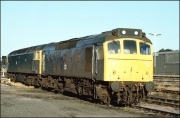 |
If engineering was scheduled at weekends in the Leamington Spa area it was commonplace for several locos to be stabled in the station area on
Saturdays. Whilst I am not a great fan of static photographs the sun shining on 25259+47005 was too much to resist on 5 October 1985.
|
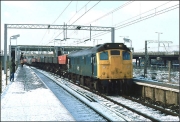 |
On 7 February 1986 there was a fall of snow around Birmingham. I had no particular plan so headed to Bescot in case the sun appeared. In the early
afternoon it did shine for a few minutes, just as 25048 appeared on a mixed freight from, I believe Coton Hill, Shrewsbury.
|
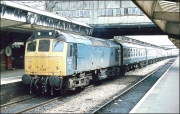 |
By mid-1986, class 25 passenger workings were few and far between and had rail-gen been in existence any movements would have set the BlackBerries and mobile phones, had they existed, beeping over
the whole country. One occasiional exception was their use on Derby to Stoke trains and here is a shot of 25313 running into the platform at Derby on 4 June 1986 with some stock. I originally thought that this might
have been a Stoke train, but I think in retrospect that there are too many coaches of different classes and assume that it was an ECS working.
|
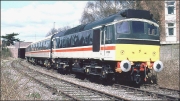 |
The final incarnation of class 25 on the main line was the conversion of 3 locos to ETHELs (Electric Train Heat Ex Locomotive) to provide train heat
for initially, class 37 hauled trains in Scotland and latterly, steam hauled trains elsewhere. Predictably, the "steam photographer" fraternity whinged about "their" locos having to drag
these "monstrosities" about and they could no longer follow their favourite pastime of "recreating the scene of bygone years". Shame. I'm sure the passengers on the trains - those paying
and thus enabling the trains to run - had no such qualms and enjoyed the warmth provided by the Ethels. Here are 2 shots, the first taken just south of Stratford-upon-Avon on 11 April 1987
and showing an Intercity liveried Ethel apparently at the head of an Intercity train. Right away Cheltenham! I wish....
|
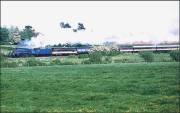 |
The final picture shows 4498 Sir Nigel Gresley + Ethel heading away from Stratford-upon-Avon with a return charter to London Marylebone. Incidentally, this shot taken at Bishopton on 24 May 1987
is completely unreapeatable, largely because several office developments have been built on the field in the foreground.
|


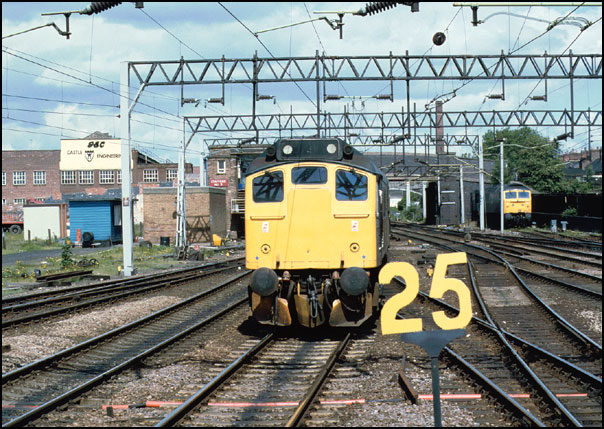

.jpg)
.jpg)
.jpg)































